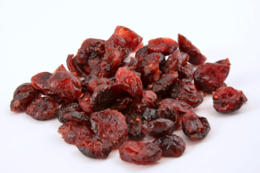Dried cranberry
This article needs additional citations for verification. (October 2009) |

Dried cranberries are made by partially dehydrating fresh cranberries, a process similar to making grapes into raisins. They are popular in trail mix, salads, breads, with cereals, or eaten on their own. Dried cranberries are sometimes referred to as craisins due to the name's similarity to raisins, though the word "Craisin" is a registered trademark of Ocean Spray Cranberries, Inc.[1] and cannot be officially applied to dried cranberries from other manufacturers.
The most commercially produced dried cranberries contain added sugar, and they may also be coated in very small quantities of vegetable oil to keep them from sticking together.[citation needed]
Many home recipes for dried cranberries involve allowing the cranberries to sit overnight in a water and sugar solution, prior to freeze-drying or air-drying.
Nutrition[]
The nutrient content of dried cranberries may vary depending on the extent of dehydration, amount of sugar added during processing, and brand. Nutrition facts for 1/3 cup (40 g) of dried cranberries are:[2]
- Calories: 123 kcal
- Water: 6 g
- Fat: 0.4 g
- Sodium: 2 mg
- Total Carbohydrates: 33 g
- Dietary Fiber: 2 g
- Sugars: 29 g
- Protein: 0 g
- Vitamin C: 0 mg
Dried cranberries have negligible fat content.[2] Other than the carbohydrates supplied, dried cranberries are a poor source of nutrients.[2]
Uses[]
This section does not cite any sources. (April 2021) |
Dried cranberries can be added for color and flavor to various foods, including salads, oatmeal, cookies, muffins, loaves, breads and trail mix. They may be used to replace raisins or any dried fruit. Dried cranberries may be prepared with flavorings or coverings, such as chocolate.
See also[]
References[]
- ^ "Craisins". Ocean Spray Cranberries, Inc. Retrieved 2009-11-02.
- ^ Jump up to: a b c "Cranberries, dried (survey)". FoodData Central, US Department of Agriculture. 2018. Retrieved 25 April 2021.
- Dried fruit
- Cranberries